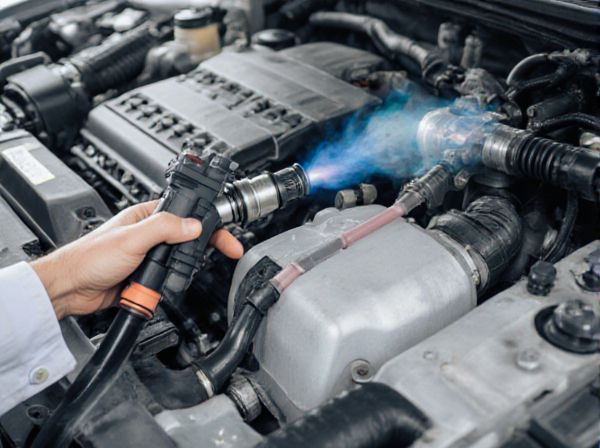
Photo illustration: Sequential Injection vs Batch-fire Injection
Sequential injection delivers fuel to each cylinder individually just before the intake valve opens, optimizing fuel efficiency and reducing emissions. Batch-fire injection sprays fuel into multiple cylinders simultaneously, simplifying the system but potentially causing less precise fuel delivery. Your engine's performance can benefit from sequential injection's precise control, especially under varying driving conditions.
Table of Comparison
| Feature | Sequential Injection | Batch-fire Injection |
|---|---|---|
| Injection Timing | Injects fuel individually, timed with each cylinder's intake stroke | Injects fuel to multiple cylinders simultaneously, not timed to intake strokes |
| Fuel Efficiency | Higher fuel efficiency due to precise fuel delivery | Lower fuel efficiency because of less precise timing |
| Emissions | Reduced emissions with better combustion control | Higher emissions due to fuel overlapping and incomplete combustion |
| Engine Performance | Smoother engine operation and improved throttle response | Less smooth operation with possible engine hesitation |
| System Complexity | More complex electronics and sensors required | Simpler design, fewer sensors needed |
| Cost | Higher initial cost due to advanced control unit | Lower cost, simpler hardware |
| Common Applications | Modern fuel-injected engines focusing on efficiency and emissions | Older or budget engines prioritizing cost savings |
Introduction to Fuel Injection Systems
Fuel injection systems regulate the delivery of fuel into an engine's combustion chamber, with sequential injection and batch-fire injection being two common methods. Sequential injection delivers fuel precisely timed to each cylinder's intake stroke, optimizing combustion efficiency and reducing emissions, whereas batch-fire injection injects fuel into multiple cylinders simultaneously, following a less precise timing cycle. Modern vehicles favor sequential injection for improved fuel economy, performance, and lower exhaust pollutants compared to the simpler but less efficient batch-fire system.
Understanding Sequential Injection
Sequential injection delivers fuel to each cylinder individually in precise timing with the intake stroke, improving fuel atomization and combustion efficiency. This method enhances engine performance, reduces emissions, and optimizes fuel economy by ensuring accurate fuel-air mixture control per cylinder. Compared to batch-fire injection, which injects fuel to multiple cylinders simultaneously, sequential injection provides finer control over injection timing and fuel usage.
Overview of Batch-fire Injection
Batch-fire injection delivers multiple fuel pulses simultaneously to groups of cylinders, simplifying the fuel delivery system compared to sequential injection. This method operates on timed intervals rather than firing each injector individually per cylinder cycle, resulting in less precise fuel metering. Batch-fire systems are typically found in older vehicles or simpler engine management setups where cost and complexity are minimized.
Key Differences Between Sequential and Batch-fire Injection
Sequential injection delivers fuel to each cylinder individually just before its intake valve opens, ensuring precise timing and improved fuel efficiency. Batch-fire injection pumps fuel to groups of cylinders simultaneously without timing synchronization, resulting in simpler design but less optimal combustion. Key differences include timing accuracy, fuel distribution control, and impact on engine performance and emissions.
Fuel Delivery Efficiency Comparison
Sequential injection delivers fuel directly into each cylinder's intake port precisely timed with the intake valve opening, enhancing fuel atomization and combustion efficiency, resulting in improved fuel economy and reduced emissions. Batch-fire injection simultaneously injects fuel into all cylinders or groups without synchronization to intake strokes, often causing fuel wastage and less efficient combustion due to fuel pooling and inconsistent air-fuel mixtures. Studies indicate sequential injection systems typically achieve up to 10-15% better fuel delivery efficiency compared to batch-fire injection, making them the preferred choice for modern fuel management in gasoline engines.
Impact on Engine Performance
Sequential injection delivers precise fuel metering to individual cylinders based on real-time data, enhancing combustion efficiency and improving throttle response. Batch-fire injection injects fuel into multiple cylinders simultaneously, which can lead to uneven air-fuel mixtures and reduced fuel economy. The optimized timing of sequential injection generally results in smoother engine operation, increased power output, and lower emissions compared to batch-fire systems.
Emissions and Environmental Considerations
Sequential injection delivers fuel directly to each cylinder's intake port in precise timing with the engine's intake stroke, resulting in more complete combustion and reduced emissions of hydrocarbons (HC) and carbon monoxide (CO). Batch-fire injection sprays fuel into multiple cylinders simultaneously, causing less efficient combustion and higher emissions due to fuel pooling and incomplete burning. The improved fuel atomization and timing accuracy in sequential injection minimize unburned fuel emissions, contributing to better compliance with stringent environmental regulations and lower overall pollutant output.
Cost and Complexity of Implementation
Sequential injection systems typically incur higher costs and greater complexity due to the need for multiple sensors, individual fuel injectors controlled precisely by the engine control unit, and advanced timing mechanisms. Batch-fire injection is more cost-effective and simpler to implement, as it fires multiple injectors simultaneously without the need for precise synchronization, reducing the number of required sensors and control hardware. Manufacturers often choose batch-fire injection for lower-cost vehicles to minimize production expenses, while sequential injection is preferred in performance or efficiency-focused applications despite its increased implementation complexity.
Applications in Modern Vehicles
Sequential injection enables precise fuel delivery by injecting fuel into each cylinder individually during the intake stroke, improving engine efficiency and reducing emissions in modern vehicles. Batch-fire injection delivers fuel to multiple cylinders simultaneously without timing to individual intake strokes, offering simpler control but less fuel economy and emissions performance. High-performance and fuel-efficient vehicles primarily use sequential injection systems for optimized combustion and compliance with stringent emissions standards.
Which Injection System is Best?
Sequential injection delivers fuel to each cylinder precisely timed with its intake stroke, optimizing combustion efficiency and reducing emissions. Batch-fire injection sprays fuel into multiple cylinders simultaneously regardless of intake timing, which can be simpler but often less efficient. Sequential injection systems are generally considered superior for performance and fuel economy due to their precise control and adaptability to engine conditions.
 caratoz.com
caratoz.com